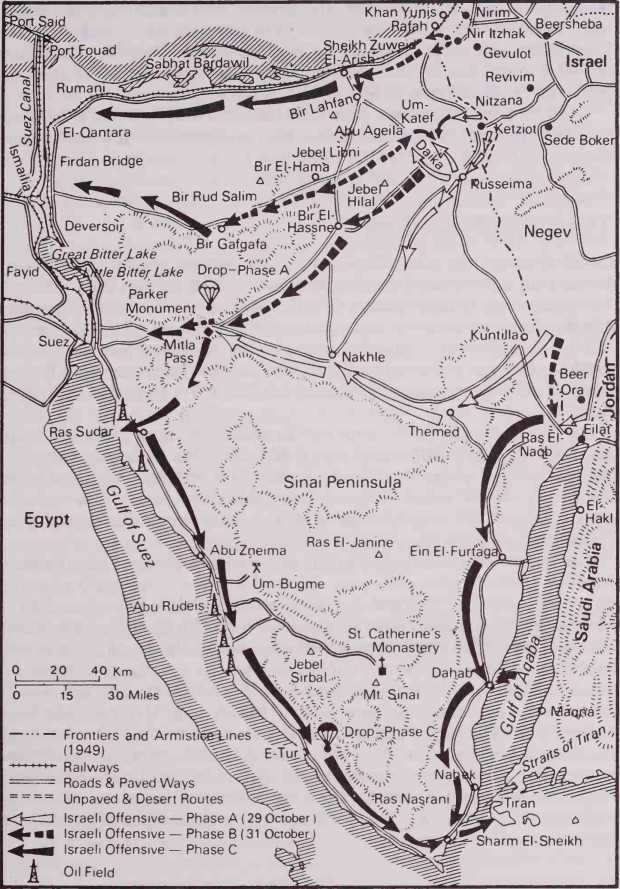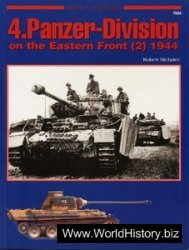The final act was a story of ingenuity, physical endurance and tenacity by a dedicated group of ‘old soldiers’ — veterans of the War of Independence. It also demonstrates the prime importance of the politico-strategic planning that enabled the achievement of one of the major aims of the campaign within the tight schedule dictated by considerations of international political pressure.
The finale started, in fact, on the opening night of the campaign when Sharon’s paratroopers were pushing their way from Kuntilla towards Themed, and when the 4th Brigade was en route to Kusseima. Parallel to
These northerly moves, close to the border at Kusseima and Kuntilla, a southern move had been planned from Ras El-Naqb, south-east of Eilat, as the starting point for the final assault on the Gulf of Aqaba and the Straits of Tiran. On that same evening of 29 October, a reconnaissance company of the 9th Infantry Brigade — a reserve brigade raised from the farmers of the valley of Jezreel under the command of Colonel Avraham Yoffe — set out from Eilat, seized the vital road junction just east of Ras El-Naqb, connecting roads from Kuntilla, Themed and Ras El-Naqb and, after clearing minefields, stormed and took the police fort in Ras El-Naqb itself. The route to the southern Sinai was now open.
The remainder of the Brigade thereafter reached Ras El-Naqb, but not directly from Eilat — a move that would have betrayed, at this early stage, the intention of the Israeli forces in the area. Instead, the Brigade moved by a roundabout route, across the Israeli Negev Desert from the north, via Kuntilla (which had earlier fallen to Sharon’s 202 Parachute Brigade on its way to Mitla).
Colonel Yoffe, a tall, heavily-built, bluff, Falstaff-like character, had served as an officer in the British Army in the Second World War, and had held command positions in the Haganah and in the Israel Defence Forces. A farmer, son of farmers, a native of Yavniel in Galilee, he was recognized as an authority on wildlife. He was later to serve as GOC Southern Command and, in the Six Day War, would command one of the divisions that penetrated the central front in the Sinai. He was for a short while to be a Member of Parliament, but his main occupation would be that of head of the Israel Nature Preservation Authority, in the course of which he established wildlife and game reserves throughout the country.
The task allotted the 9th Infantry Brigade was in many ways the most difficult of the campaign — to advance along the rough west coast of the Gulf of Aqaba, an area of steep, saw-tooth ridges dropping straight into the sea; an area strewn with huge boulders, deep sand, and ravines; excruciatingly hot, devoid of water and, above all, a camel route that had not been designed for passage by a fully-motorized infantry brigade. The length of the route was approximately 150 miles over difficult and frequently well-nigh impassable terrain. Such a trek required selfsufficiency in supplies, water and petrol, at least until such points as would permit the landing of supplies by sea were reached. The Brigade consisted of 200 vehicles and 1,800 men, formed into two infantry battalions on half-tracks and 6x6 trucks, a reconnaissance unit, an artillery battery, one heavy mortar battalion, an anti-aircraft troop, engineers, workshop and service detachments. A tank unit would be transported by naval landing craft that had been specially transported by rail and road from Haifa to Eilat. This force was to face a defending garrison of 1,500 Egyptians comprising two infantry battalions emplaced in stone and concrete fortifications with an extensive collection of artillery, based on Sharm El-Sheikh and its outer position at Ras Nasrani.
The Brigade covered the first 60 miles along Wadi Watin as planned, widely spread out with units seven miles apart in order to reduce dust and ensure constant mobility. After passing the oasis of Ein El-Furtaga the
Brigade met the major physical obstruction — a steep uphill climb through Wadi Zaala, with deep, boulder-strewn, powdery sand in which most of the vehicles sank and had to be pushed, pulled or shifted by hand. Upon reaching the large coastal oasis of Dahab, on 3 November, the advance guard found itself faced with a camel-riding section of the Egyptian ‘motorized’ Frontier Force — the desert police force — which set up an ambush there. Because of a lack of caution, the 9th Brigade suffered a number of casualties here.
After resting and refuelling from landing craft sent by sea from Eilat to Dahab, the Brigade set out at 18.00 hours on 3 November, passing through the narrow Wadi Kid, a goat track flanked by steep walls, only two yards wide in some places. Here, as expected, the Egyptians had placed a platoon with bazookas and machine-guns to block any possible advance by small Israeli units, and had mined the route. But, after a few shots, the isolated Egyptian unit withdrew, the obstacle was overcome and the sappers proceeded to widen the defile in order to enable the Brigade to pass through. By noon on 4 November, they were at Ras Nasrani, there to discover that this heavily fortified citadel, with its reinforced concrete bunkers, communication trenches, minefields and concertina wire, had been vacated by the Egyptian garrison, which had withdrawn westwards in order to regroup for the defence of Sharm El-Sheikh. This may have been due to the fact that elements of 202 Parachute Brigade were meanwhile advancing from A-Tor in the north, so that concentrating the Egyptian forces on Sharm El-Sheikh became strategically necessary for its defence. Sharm El-Sheikh was a rear supply-base, complete with large storehouses and airport, but hardly equipped to withstand an armoured attack.
The assault on the outer defences of Sharm El-Sheikh, which were built on a chain of hills, Tsafrat-el-At, about three miles to the north, commenced in the early afternoon of 4 November, in co-ordination with the Parachute Battalion, which had closed in from the north-west and halted fifteen miles north of Sharm El-Sheikh in order to prevent any attempted push to the west by the Egyptian force stationed there. The outer defences of Tsafrat-el-At fell to the 9th Brigade reconnaissance unit after an aerial rocket and machine-gun attack. (Air co-operation in this final move encountered no opposition owing to the fact that the activity of the Egyptian Air Force in the Sinai had been neutralized both by Israeli action and by the Anglo-French bombing of Egyptian air bases west of the Suez Canal.) At 03.30 hours the next day, the 91st Battalion assaulted the outer defences of Sharm El-Sheikh on the western flank of the locality — without any clear picture of the extent of the enemy defence works. Consequently, heavy Egyptian fire, from three fortified positions, and an extensive minefield caused heavy casualties. The 91st Battalion withdrew, moving in darkness, with the wounded loaded in half-tracks. Part of the withdrawing force stumbled on one of the anti-tank positions that had so successfully engaged them in their assault, only to discover that this position had in the meantime been vacated by the Egyptian forces, leaving behind anti-tank weapons and an open telephone line to the Egyptian Headquarters!

Ths Israeli Offensive Phase C, 2-5 November 1956
One hour later, at 05.30 hours, and following a 120mm mortar and aerial barrage, the half-track company and reconnaissance unit, followed by infantry units, set out along the western flank to mop-up the emplacements, whilst the 92nd Battalion broke through on the eastern flank.
Reaching the airport. Thereafter, the Brigade took control of the locality and, by 09.00 hours on 5 November, the Egyptian command post had been taken and units of Sharon’s 202 Parachute Brigade, which had moved down along the Gulf of Suez from Ras Sudar via A-Tor, met up with Yoffe’s 9th Brigade in Sharm El-Sheikh.
By 09.30 on 5 November, the war in the Sinai was over and the Straits had been opened. The following day, in compliance with the demands of the United Nations, a cease-fire came into force.




 World History
World History









